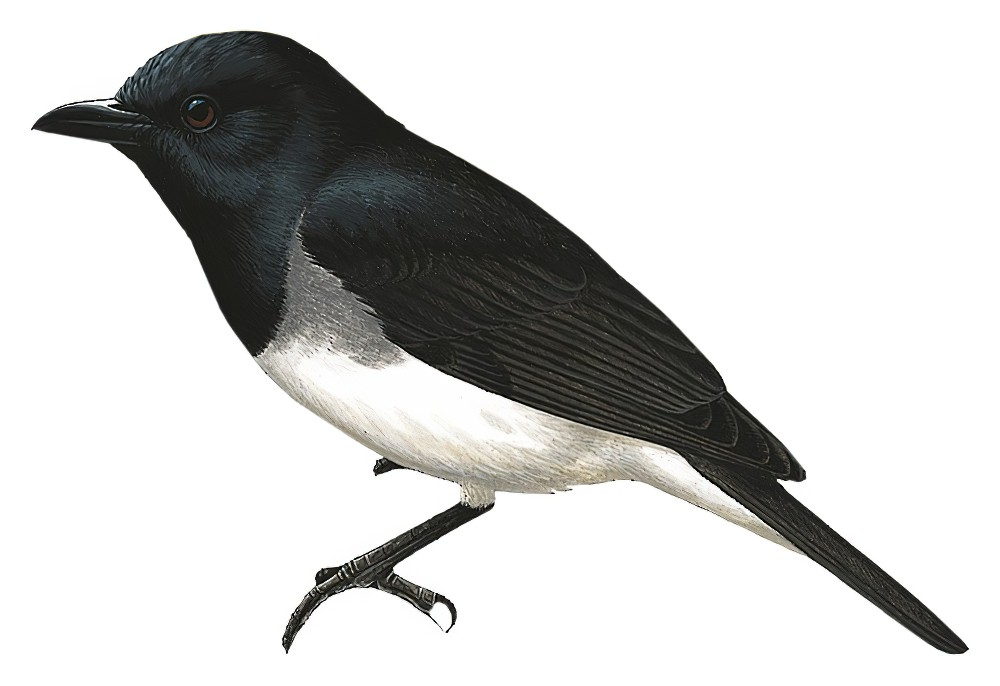Black-headed Whistler / Pachycephala monacha

Black-headed Whistler
SCI Name:
Protonym: Pachycephala ? monacha Proc.Zool.Soc.London Pt26 no.358 p.179
Taxonomy: Passeriformes / Pachycephalidae / Pachycephala
Taxonomy Code: blhwhi1
Type Locality: Aru Islands.
Author: Gray, GR
Publish Year: 1858
IUCN Status: Least Concern
DEFINITIONS
PACHYCEPHALA
(Pachycephalidae; Ϯ Golden Whistler P. pectoralis) Gr. παχυς pakhus large, thick; κεφαλη kephalē head; from the appearance of their large rounded heads the Indomalayan and Australasian whistlers were formerly known as 'thickheads'; "The interval betweeen the present groups and those of the Pari, where we entered on the family [Pipridæ], appears to be filled up by a race of birds peculiar to New Holland, and hitherto uncharacterized, of which the Muscicapa pectoralis, Lath. is the type*. These, uniting many external characters, at least, both of the Berry-Eaters and Flycatchers, exhibit also in general appearance a considerable resemblance to the Pari, and will be found, I conjecture, to be the connecting bond between all these groups. ... * Mr. Swainson has lately formed this group into a genus by the name of Pachycephala. Nov. 1824." (Vigors 1825); "Genus. PACHYCEPHALA*. Swains. MSS. ... Caput tumidiusculum. ... In their general appearance some of the species exhibit a resemblance to the birds of the genus Procnias, Ill., while by the puffed-out appearance of the feathers about the head, we trace an approximation to some of the Linnean Pari. ... * παχυς crassus, and κεφαλη caput" (Vigors & Horsfield 1827).
Var. Pachycephalus.
Synon. Alisterornis, Gilbertornis, Hylocharis, Hyloterpe, Lewinornis, Malacolestes, Mattingleya, Musciterpe, Muscitrea, Mutevodia, Pachycilodryas, Psaltricephus, Pucherania, Timixos.
monacha
Late. L. monacha nun (i.e. hooded) < Gr. μοναχη monakhē nun < μονος monos solitary < μοναχοω monakhoō to make single.
● ex “Moloxita” or “Réligieuse d’Abissinie” of de Buffon 1770-1783, and “Nun Thrush” of Latham 1783 (Oriolus).
MONASA
(Bucconidae; Ϯ Black Nunbird M. atra) Gr. μονας monas, μοναδος monados female hermit, nun < μονος monos solitary < μοναχοω monakhoō to make single; "35. MONASE, Monasa. Cuculus, Gm. Bucco, Lath. Bec garni de soies à la base, plus long que la tête, comprimé par les côtés, entier; mandibules courbées en en base. Esp. Coucou noir de Cayenne, Buff. ... Monasa [μονασης, qui solus vivit]." (Vieillot 1816); "Monasa Vieillot, Analyse, 1816, p. 27. Type, by monotypy, Coucou noir de Cayenne of Buffon = Cuculus ater Boddaert." (Peters 1948, VI, 21).
Var. Monassa, Monasta, Monacha, Monesa, Monaca.
Synon. Barbacou, Barbaculus, Monadon, Monastes, Scotocharis.
MONARCHA
(Monarchidae; Ϯ Black-faced Monarch M. melanopsis) L. monarcha monarch < Gr. μοναρχος monarkhos monarch, sovereign, dictator (see Tyrannus); "Genus. MONARCHA. Rostrum forte, subelongatum, basi latum, subdepressum; culmine carinato, apice arcuato; mandibula superiore emarginata; naribus basalibus, rotundis, setis plumulisque opertis; rictu vibrissis fortibus instructo. Alæ mediocres, subrotundatæ; remige prima brevi, secunda duplo longiore, tertia et quinta æqualibus, quarta quæ est longissima, paulo breviori; cæteris gradatim breviscentibus: tertiæ ad sextam inclusam pogoniis externis paulatim in medio latioribus. Cauda mediocris, æqualis. Pedes mediocres, acrotarsiis scutellatis, paratarsiis integris. The powerful construction of the bill of this group separates it at once from the other species of the Muscicapidæ, with which in the depression and breadth at the base of that member, the strength of the rictal bristles, and the general characters of the wings and legs, it otherwise accords. This strength of bill would incline us to place the bird among the Laniadæ, and in the subfamily of Tyrannina, Swains., of which it might thus be considered to form the Australian representative, did not the other characters of its structure evince a more predominant inclination to the Muscicapidæ than to the Tyranni. The group may, however, be considered to stand intermediately between the two families; and might perhaps be referred with equal propriety to either, according to the characters which each naturalist would select as most predominant, and most convenient to guide him in his subdivisions. The habits of the birds of this group, hitherto unknown, will have much influence in determining its exact station. 1. CARINATA. ... Muscipeta carinata. Swains. Zool. Illust. pl. 147." (Vigors & Horsfield 1827); "Monarcha Vigors and Horsfield, 1827, Trans. Linn. Soc. London, 15, p. 254. Type, by monotypy, Muscipeta carinata Swainson, 1823 = Muscicapa melanopsis Vieillot, 1818." (Mayr in Peters 1986, XI, 500).
Var. Monacha, Monarches (Gr. μοναρχης monarkhēs monarch).
Synon. Bathmisyrma, Monarcharses, Neopomarea.
SUBSPECIES
Black-headed Whistler (monacha)
SCI Name: Pachycephala monacha monacha
monacha
Late. L. monacha nun (i.e. hooded) < Gr. μοναχη monakhē nun < μονος monos solitary < μοναχοω monakhoō to make single.
● ex “Moloxita” or “Réligieuse d’Abissinie” of de Buffon 1770-1783, and “Nun Thrush” of Latham 1783 (Oriolus).
Black-headed Whistler (dorsalis)
SCI Name: Pachycephala monacha dorsalis
dorsale / dorsalis
L. dorsalis (properly dorsualis) dorsal, of the back < dorsum back.
● ex “Chorlito à dos noir” of de Buffon (Sonnini ed.) 1800-1802 (syn. Calidris melanotos).
UPPERCASE: current genus
Uppercase first letter: generic synonym
● and ● See: generic homonyms
lowercase: species and subspecies
●: early names, variants, mispellings
‡: extinct
†: type species
Gr.: ancient Greek
L.: Latin
<: derived from
syn: synonym of
/: separates historical and modern geographic names
ex: based on
TL: type locality
OD: original diagnosis (genus) or original description (species)












